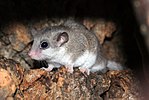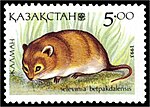Threatened Species due to its wide range and stable population trend. Forest dormice have a diploid count (2n) of 48 chromosomes. Even though this species...
14 KB (2,124 words) - 17:46, 3 June 2024
Hazel dormouse (redirect from Hazel dormice)
Conservation Handbook, hazel dormice are "particularly associated with deciduous woodland" but also inhabit hedgerows and scrub. Dormice seldom travel more than...
15 KB (1,568 words) - 02:53, 18 July 2024
Graphiurus (redirect from African dormice)
The African dormice (genus Graphiurus) are dormice that live throughout sub-Saharan Africa in a variety of habitats. They are very agile climbers and have...
3 KB (224 words) - 15:35, 1 February 2024
the future. Edible dormice inhabit deciduous forests dominated by oak and beech, from sea level to the upper limits of such forests at 1,500 to 2,000 m...
34 KB (3,805 words) - 23:46, 23 August 2024
Dryomys (category Dormice)
members of the genus are referred to as forest dormice, although the type species also goes by the common name forest dormouse. The species within the genus...
884 bytes (84 words) - 16:11, 21 May 2022
conditions (rain, frost) and predators (woodpeckers, bears, pine martens, forest dormice). Harvest of honey from these did not destroy the colony, as only a...
47 KB (5,889 words) - 15:46, 14 August 2024
Japanese dormouse (category Dormice)
Glirulus. Its natural habitat is temperate forests. In Japanese, it is called yamane (やまね or 山鼠). Among dormice, it has the special ability of running at...
4 KB (366 words) - 04:04, 22 May 2024
Leithiinae (category Dormice)
Dryomys laniger Balochistan forest dormouse, Dryomys niethammeri Forest dormouse, Dryomys nitedula Genus Eliomys, garden dormice Asian garden dormouse, Eliomys...
2 KB (145 words) - 00:32, 7 February 2022
rodents. Its natural habitats are subtropical or tropical, moist montane forests and rivers. This is a small species with soft silky hair. The eyes are...
4 KB (491 words) - 20:53, 7 August 2024
but its range extends into the north. Garden dormice are often found in the Alps, the Bavarian Forest, and the Ore Mountains. The species is also present...
9 KB (941 words) - 21:53, 22 April 2024
Hypnomys (category Dormice)
Hypnomys, otherwise known as Balearic giant dormice, is an extinct genus of dormouse (Gliridae) in the subfamily Leithiinae. Its species are considered...
18 KB (2,095 words) - 04:34, 23 May 2024
Balochistan forest dormouse (Dryomys niethammeri) is a species of rodent in the family Gliridae. It is native to Pakistan. The Balochistan forest dormouse...
2 KB (121 words) - 15:10, 13 November 2022
Libya, Saudi Arabia, Syria and Turkey. Its natural habitats are temperate forests, subtropical or tropical dry shrubland, Mediterranean-type shrubby vegetation...
6 KB (803 words) - 10:46, 30 June 2023
mouse-tailed dormouse is nocturnal, which means that they are active at night. Dormice are active from 1–2 hours before sunset till 1–2 hours after sunrise. In...
5 KB (591 words) - 22:09, 5 May 2024
Desert dormouse (category Dormice)
family allied to Myoxidae (some taxonomists call this family Gliridae), the dormice. By 1947, they had concluded that it should be placed in Leithiinae, a...
5 KB (601 words) - 23:11, 4 September 2024
sichuanensis) Dryomys (Forest dormice) Woolly dormouse (Dryomys laniger) Balochistan forest dormouse (Dryomys niethammeri) Forest dormouse (Dryomys nitedula)...
2 KB (218 words) - 07:26, 29 February 2024
sichuanensis) Dryomys (Forest dormice) Woolly dormouse (Dryomys laniger) Balochistan forest dormouse (Dryomys niethammeri) Forest dormouse (Dryomys nitedula)...
2 KB (176 words) - 14:52, 13 April 2023
Bombek, Dominik; Mahmoudi, Ahmad (2021-07-01). "A taxonomic revision of fat dormice, genus Glis (Rodentia)". Mammalia. 85 (4): 362–378. doi:10.1515/mammalia-2020-0161...
18 KB (1,736 words) - 16:23, 26 August 2024
the Congo. Its natural habitat is subtropical or tropical moist lowland forests. Grubb, P. & Schlitter, D. 2008. Graphiurus christyi. 2006 IUCN Red List...
1 KB (89 words) - 18:45, 29 February 2024
Chinese dormouse (category Dormice)
(Chaetocauda sichuanensis) is a species of dormouse found in subalpine mixed forests in northern Sichuan, China, where it is known from Jiuzhaigou and Wanglang...
2 KB (230 words) - 15:09, 13 November 2022
Kenya and Tanzania. Its natural habitats are subtropical or tropical dry forests, and moist or dry savannah. Kellen's dormouse has a head-and-body length...
4 KB (402 words) - 15:18, 13 November 2022
and Gabon. Its natural habitat is subtropical or tropical moist lowland forests. Holden, M. E.. 2005. Family Gliridae. pp. 819–841 in Mammal Species of...
1 KB (91 words) - 18:47, 29 February 2024
Morocco, Tunisia and Western Sahara. Its natural habitats vary from humid forests to semi-deserts. It is a common species and the International Union for...
5 KB (488 words) - 20:43, 2 March 2024
is a genus of rodent in the family Gliridae, commonly known as garden dormice. It contains the following extant species: Asian garden dormouse, Eliomys...
2 KB (171 words) - 04:47, 10 December 2023
depredation caused by the non-native grey squirrel, edible dormice (in the Chilterns) and deer, this forest ecoregion is considered at high risk, with a critical/endangered...
16 KB (1,841 words) - 21:30, 18 May 2024
sichuanensis) Dryomys (Forest dormice) Woolly dormouse (Dryomys laniger) Balochistan forest dormouse (Dryomys niethammeri) Forest dormouse (Dryomys nitedula)...
1 KB (82 words) - 18:05, 2 March 2024
300 to 6,600 ft) above sea level. Its natural habitat is tropical dry forests. Although the population size is unknown, it is thought to be generally...
5 KB (610 words) - 15:16, 13 November 2022
sichuanensis) Dryomys (Forest dormice) Woolly dormouse (Dryomys laniger) Balochistan forest dormouse (Dryomys niethammeri) Forest dormouse (Dryomys nitedula)...
1 KB (104 words) - 15:20, 13 November 2022
Sierra Leone. Its natural habitat is subtropical or tropical, moist lowland forests. Grubb, P. & Schlitter, D. 2004. Graphiurus crassicaudatus. 2006 IUCN Red...
1 KB (98 words) - 23:02, 1 March 2024

















